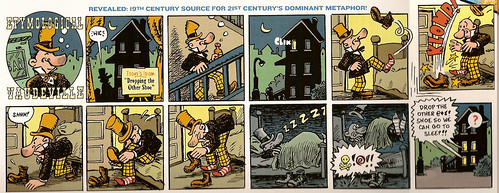At TPM, Paul Rieckhoff asks: "Seven Years Later: Why Is There Still A Hole at Ground Zero?" I actually wrote a little bit about this myself at the end of a paper on 9/11 for a class last year. Here were my thoughts.
Waiting for the Other Shoe to Drop
Although I grew up forty miles from New York City, I was in Cleveland, Ohio, on September 11, 2001, finishing my senior year of college. From the time my father called to wake me and let me know about the first attack, I watched the news coverage nearly continuously. I remember, vividly, the chaos, the violence, and the uncertainty, but I also remember events which are no longer referenced, the phantom attacks: false reports of car bombs on New York Bridges and outside the State Department, threats and evacuations across the country reported once and then never mentioned again. In Cleveland, at least, it was initially reported that United 93 had crashed into Camp David; the anchor also told us that there were as many as 20 planes out of contact with the FAA still in the air and that any number of them—possibly all—could have been hijacked. One of the planes forced to land at Cleveland Hopkins airport was raided (on live TV), believed to have terrorists aboard; this was later revealed to have been entirely a false alarm.
In the face of so many reports, only four attacks becomes something like a relief—the violence of that day might have been so much worse. It might have never ended. And yet the deluge of phantom attacks, attacks which seemed to have happened but which never actually did, which like the collapse of the Towers themselves have been put under erasure, have left us for a long time with the foreboding sense that another attack is always just around the corner, that at any moment the world will again be shattered by terrible violence. We are waiting for the other shoe to drop. The Department of Homeland Security’s threat level is, after all, always “Elevated,” if not “High”; nightly news reports regale us with wild possibilities of where the terrorists might strike next, anything from blowing up the Hoover Dam to poisoning local gumball machines.*
This feeling of permanent, unmitigated existential threat may have diminished somewhat since September 11, but it has never really left us, and it feeds into the sensation of temporal loop caused by the day’s reconsumption as a spectacle. Though the attacks lasted only a few hours on one very devastating morning, on the level of the symbolic—on the level of spectacle—they remain ongoing and unending. This is why, I think, Freedom Tower, long scheduled to be built on the ruins of Ground Zero, remains unbuilt and perhaps in some real sense unbuildable. We remain deeply embedded in the singularity; although time passes, it cannot progress. More than anything else, this loss of temporal perspective, the foreshortening of memory itself, is the psychic cost of the refusal to come to terms with September 11, the cost of rebranding the shocking anti-spectacle of September 11 as the spectacle of “9/11” and consuming it anew, over and over again. On the level of the spectacle, the towers are always smoking; though we all saw it happen, we can never allow them to collapse.
--
* I’m partial to this story because it concerns the town next door to the town in which I grew up, and because it involves the most ludicrous potential terror attack I’ve heard of. Stories like this one have aired across the country since September 11—perhaps, somewhere or another, every single night.
Thursday, September 11, 2008
Posted by
Gerry Canavan
at
6:52 PM
![]()
Labels: 9/11, disaster, Freedom Tower, Ground Zero, memory, New York, politics, spectacle





|